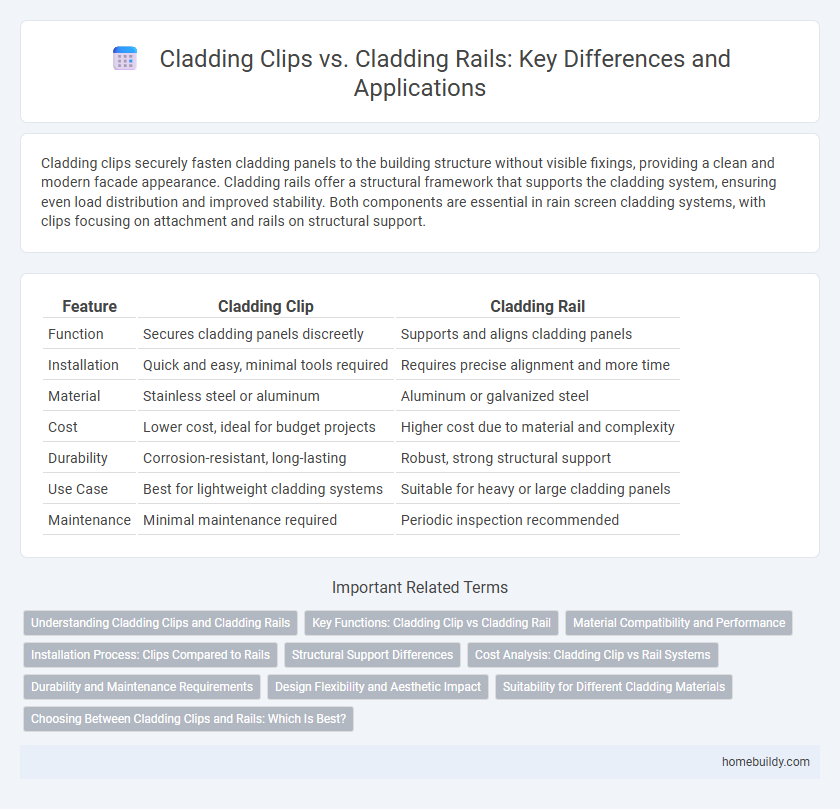Cladding clips securely fasten cladding panels to the building structure without visible fixings, providing a clean and modern facade appearance. Cladding rails offer a structural framework that supports the cladding system, ensuring even load distribution and improved stability. Both components are essential in rain screen cladding systems, with clips focusing on attachment and rails on structural support.
Table of Comparison
| Feature | Cladding Clip | Cladding Rail |
|---|---|---|
| Function | Secures cladding panels discreetly | Supports and aligns cladding panels |
| Installation | Quick and easy, minimal tools required | Requires precise alignment and more time |
| Material | Stainless steel or aluminum | Aluminum or galvanized steel |
| Cost | Lower cost, ideal for budget projects | Higher cost due to material and complexity |
| Durability | Corrosion-resistant, long-lasting | Robust, strong structural support |
| Use Case | Best for lightweight cladding systems | Suitable for heavy or large cladding panels |
| Maintenance | Minimal maintenance required | Periodic inspection recommended |
Understanding Cladding Clips and Cladding Rails
Cladding clips provide a secure and concealed fastening method for exterior panels, offering increased flexibility and ease of installation compared to cladding rails. Cladding rails serve as structural support frameworks that distribute loads and ensure alignment but often require more material and labor. Understanding the differences in load distribution, installation complexity, and aesthetic outcomes is essential for choosing the appropriate system for building facades.
Key Functions: Cladding Clip vs Cladding Rail
Cladding clips provide secure attachment points for panels, enabling easy installation and allowing for thermal expansion without compromising structure integrity. Cladding rails serve as supportive frameworks that distribute loads evenly across the cladding system, enhancing overall stability and alignment. Both components work together to ensure long-lasting facade performance and efficient maintenance.
Material Compatibility and Performance
Cladding clips are typically made from stainless steel or aluminum, offering excellent corrosion resistance and compatibility with various cladding materials like metal, wood, and composite panels. Cladding rails, often constructed from aluminum or galvanized steel, provide structural support but may face compatibility issues with certain materials prone to galvanic corrosion. The choice between clips and rails depends on desired durability, load-bearing capacity, and the specific cladding system requirements for optimal performance.
Installation Process: Clips Compared to Rails
Cladding clips offer a streamlined installation process by snapping directly onto the facade, reducing labor time and the need for specialized tools compared to cladding rails. Clips align precisely with panels, minimizing adjustments and ensuring consistent spacing, whereas rails require pre-measured layouts and secure fastening to the substrate. This difference results in faster assembly and a cleaner finish when using cladding clips over traditional rails.
Structural Support Differences
Cladding clip systems offer flexible attachment points that enhance thermal expansion accommodation and reduce structural stress compared to cladding rails, which provide continuous linear support but can transfer more load to the substrate. Clips allow for precise alignment and easier replacement of panels, improving overall structural resilience, whereas rails emphasize uniform load distribution but may require more extensive framework reinforcement. The choice between cladding clips and rails significantly impacts the load-bearing dynamics and long-term durability of building facades.
Cost Analysis: Cladding Clip vs Rail Systems
Cladding clips typically offer a lower initial cost compared to cladding rail systems due to simpler installation processes and reduced material requirements. Rail systems involve higher expenses linked to their structural components and labor-intensive setup, impacting overall project budgets. When evaluating cost efficiency, cladding clips provide a more budget-friendly option without compromising durability or performance in facade applications.
Durability and Maintenance Requirements
Cladding clips offer superior durability due to their corrosion-resistant materials and hidden fixing design, reducing exposure to environmental elements compared to cladding rails. Maintenance requirements for cladding clips are minimal, as their concealed installation prevents debris buildup and simplifies cleaning, whereas cladding rails often require regular inspection and upkeep to address potential corrosion or mechanical wear. Selecting cladding clips enhances long-term performance and reduces lifecycle costs in facade systems.
Design Flexibility and Aesthetic Impact
Cladding clips offer superior design flexibility by allowing individual panels to be easily adjusted, replaced, or removed without dismantling the entire system, enhancing customization possibilities. Cladding rails, while providing strong structural support, limit aesthetic options due to fixed fastening points and visible rail profiles that can disrupt seamless facades. The use of cladding clips results in a cleaner, more streamlined appearance, making them ideal for modern architectural designs emphasizing minimalism and smooth surfaces.
Suitability for Different Cladding Materials
Cladding clips offer enhanced suitability for lightweight and thin cladding materials such as vinyl, aluminum, and composite panels by providing secure fastening without compromising material integrity. Cladding rails, in contrast, are better suited for heavier or thicker materials like timber and fiber cement boards, as they provide robust structural support and even load distribution. Choosing between clips and rails depends on the cladding material's weight, thickness, and installation requirements for optimal durability and performance.
Choosing Between Cladding Clips and Rails: Which Is Best?
Cladding clips offer a streamlined installation process and enhanced ventilation by securely fastening panels without visible fixings, reducing thermal bridging compared to cladding rails. Cladding rails provide greater structural support for heavier or larger cladding panels, making them ideal for high-load applications and complex facade designs. Selecting between cladding clips and rails depends on factors such as panel weight, facade design complexity, ventilation requirements, and installation efficiency.
Cladding clip vs Cladding rail Infographic

 homebuildy.com
homebuildy.com